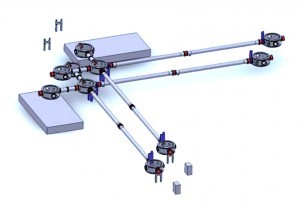Is the Universe real or just an illusion? The holometer aims to find out...
By Grant Banks
13:45 November 4, 2010
A team of researchers at the US Department of Energy's Fermilab are trying to take a measurement of the fabric of spacetime to show that there is a finite unit that makes up the universe. To do so, they have created the world's most accurate clock, the holographic interferometer or holometer.
Is reality a 3D hologram of a 2D universe? This is a question that the researchers are asking almost a hundred years after physicist Max Planck came up with the idea of a finite measurement of distance, leading to the concept of Planck distance and Planck time. Stephen Hawking built on this concept to suggest that there is a discrete fidelity or resolution to the universe – sort of like pixels in a picture. Further credence was given to the idea when German scientists working on the GEO600 project noticed distortions in their observations while studying the gravitational waves created by black holes. The cause of this distortion is thought to be because the team were approaching the lower limit of the universe's resolution. They might have been the first to see the fabric of reality! So, why is the universe two-dimensional you ask? Because at these smallest of distances (Planck scale units), time and the third dimension of space become intertwined or one, leaving only two spatial dimensions or a 2D universe.
What the team at Fermilab are trying to achieve is to take a measurement of this fabric of spacetime, to show that there is a finite unit that makes up the universe. To do this they have created the world's most accurate clock, the holographic interferometer or holometer. While the team are currently testing a one-meter (3.28-foot)-long prototype of the instrument, they plan to take readings using a 40m (131-foot) device which will be constructed in the coming months.
“If there is a minimum interval of time, or a maximum frequency in nature, there is a corresponding limit on the fidelity of space and time. Everyone is familiar these days with the blurry and pixelated images, or noisy sound transmission, associated with poor internet bandwidth. The holometer seeks to detect the equivalent blurriness or noise in reality itself, associated with the ultimate frequency limit imposed by nature,” the Fermilab team said.
“More recently, theoretical studies of black holes, and later in string theory and other forms of unification, have suggested that physics on the Planck scale is holographic. It is conjectured that space is two dimensional, and the third dimension is inextricably linked with time. If so, our three-dimensional world is a kind of approximate illusion that emerges only on scales much larger than the Planck length.”
The holometer works by splitting a light beam in two, with the two separate parts traveling in different directions and then being brought back together. Once they are brought together, any distortion can be measured. What Fermilab particle astrophysicist Craig Hogan suggests is that these distortions would be caused by spacetime having a finite resolution or Planck scale.
“People trying to tie reality together don’t have any data, just a lot of beautiful math. So we want to build a machine which will be the most sensitive measurement ever made of spacetime itself, that’s the holometer. The hope is that this gives them something to work with,” Hogan said.
Murmurs in the scientific community are already discrediting the ideas, as they are created out of math rather than hard data, and because they contradict the fundamentals of classical geometry. Even so, Hogan believes that his theory would answer many of the unanswered questions surrounding black holes and in other areas of theoretical physics. It is also thought by many that the distortions observed by the German team on the GEO600 project were due to equipment noise, and not because of approaching a theoretical limit of the universe's resolution.
The first data obtained by the holometer is expected sometime next year.
Via Symmetry Breaking.
Copyright © gizmag 2003 - 2010 To subscribe or visit go to: http://www.gizmag.com

